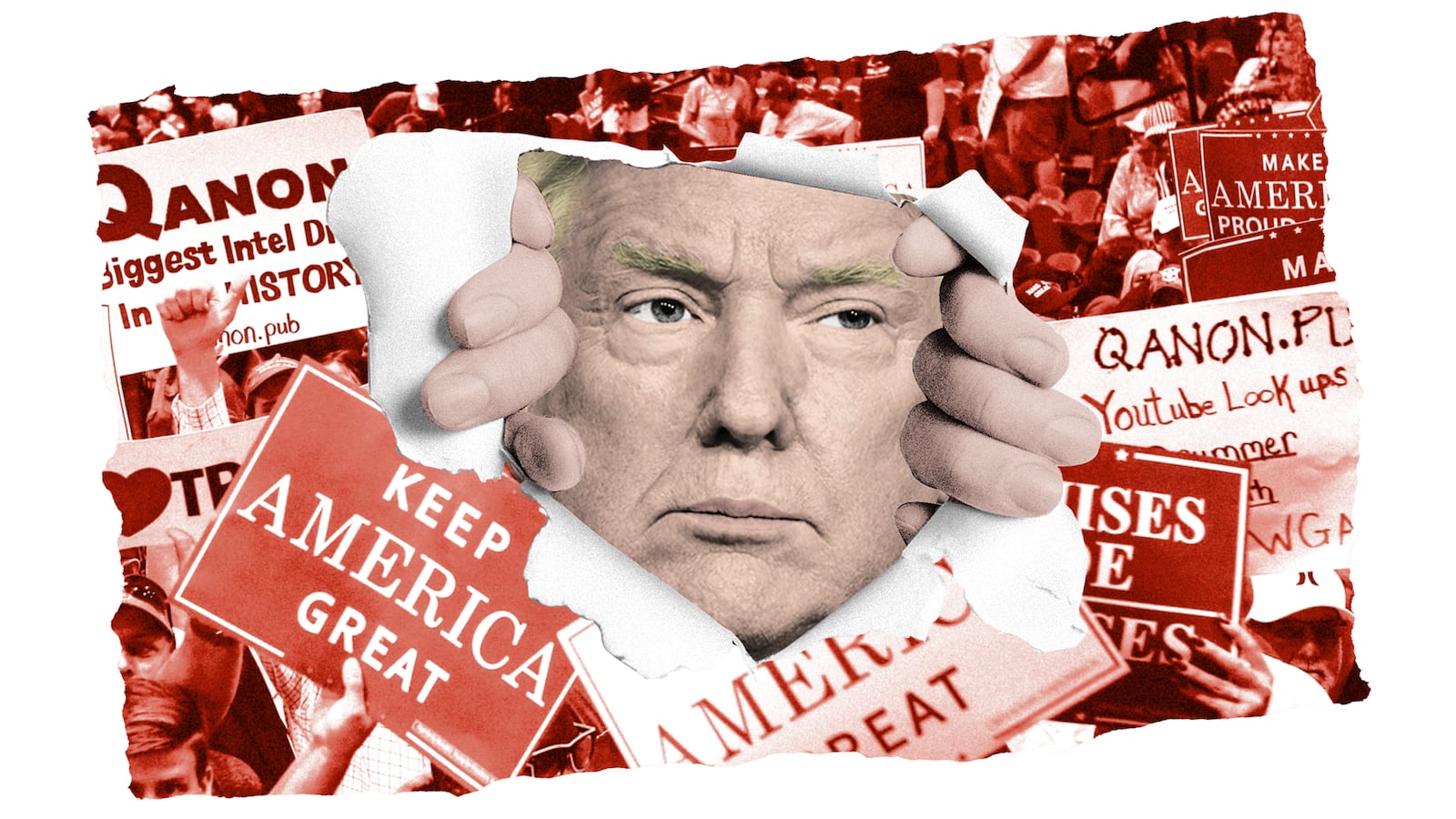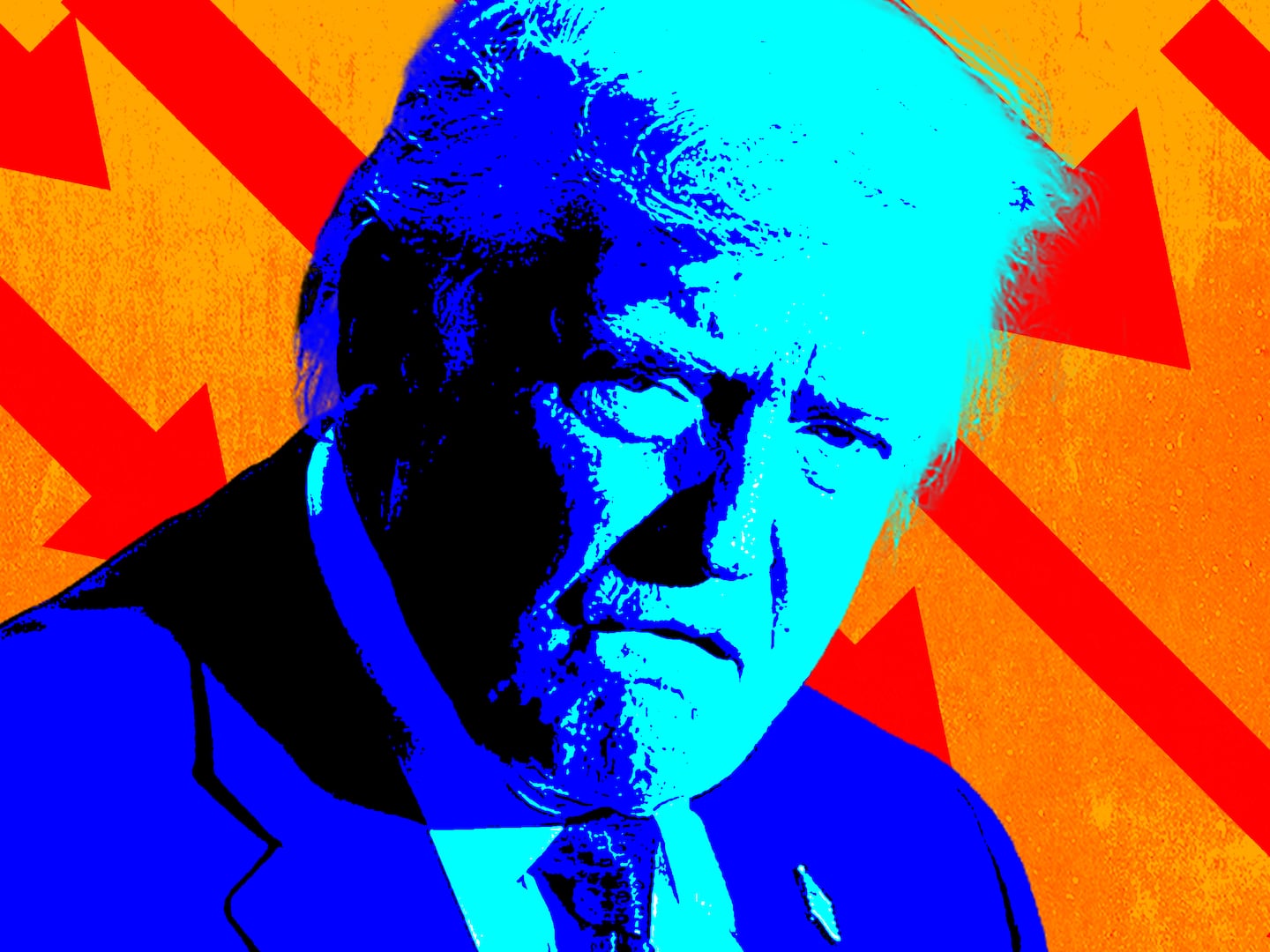In late August 2018, Lisa and John Welch weren’t feeling great about the future of QAnon, the ludicrous conspiracy theory that posits that Donald Trump is engaged in a secret battle with pedophilic elites in Hollywood, big banks, and the Democratic Party.
Lisa had bought into the theory first, then convinced her husband to sign on. But none of the mysterious Q’s predictions in anonymous internet forums had come to pass nearly a year after it started in October 2017, and QAnon believers were starting to lose faith. After yet another Q prediction failed to materialize in 2018, an armed, crazed QAnon fan allegedly shut down a bridge near the Hoover Dam with an improvised armored truck.
The Welches decided they needed some way to show how many Trump supporters believed in the mega-conspiracy theory, which has pulled in Pizzagate and a wide range of other conspiracy theories. They printed up T-shirts and signs that said “We Are Q” and passed them out at a Trump rally in Tampa, Florida.
“We took ’em to the rally and handed ’em out, and the rest is history,” Lisa Welch told a crowd of roughly 100 QAnon believers who gathered to rally across the street from the White House on Wednesday.
The Welches’ signs and T-shirts, along with other QAnon-related signs and “Q” cut-outs, were unavoidable in cable news coverage of the rally. Suddenly, people all over the country were asking what why a segment of Trump fans adored the letter Q, and QAnon believers were invigorated.
“By the time the rally was over, they didn’t have any choice but to put us on [TV],” said John Welch.
The Tampa rally wasn’t the first time QAnon believers had appeared among Trump’s faithful, but it did show QAnon fans that showing up to the rallies with Q signs and clothes could have a real world effect.
Now QAnon believers eager to appear at Trump rallies are posing a challenge to the president’s reelection. As Trump faces a tough campaign, some of his most visible supporters come from QAnon-world, where various factions include 9/11 Truthers, anti-Semites, and people who think John F. Kennedy Jr. is still alive and will soon return to arrest Democrats.
But to QAnon supporters, Trump rallies are a great chance both to see the president and to get their message out without going through a media they claim is biased against them.
“It’s like Trump tweeting,” said Pennsylvania contractor Daniel Graham, who drove to Washington for Wednesday’s rally.
To Team Trump, though, QAnon diehards who adore Trump and garner media coverage and camera shots at his 2020 rallies have been a longtime nuisance. One current senior Trump campaign official told The Daily Beast that the standard operating procedure among most staff has been to generally just “ignore them” and not “make a big deal out of” them, both to deprive them of as much press attention as possible and to avoid “pissing off the crazy” people.
In a particularly weird bit of Trumpworld drama that unfolded earlier this year, QAnon believers turned on and began targeting former Trump aide Sebastian Gorka after he called their beliefs “GARBAGE.” Since the Tampa rally, Gorka and other Trump allies have struggled to stop QAnon’s spread, on the grounds that it’s an embarrassment to the larger Trump coalition.
And over the past year, more and more QAnon fans who also support Trump have alleged that their Q gear and shirts have been banned from the president’s rallies, and they have accused security personnel of instructing them to, for instance, turn their T-shirts inside out. The U.S. Secret Service, for its part, has publicly denied that it is involved in QAnon suppression at Trump rallies. If QAnon-related clothing and signs are banned, it’s possible that the ban has been imposed by additional, hired security guards, rather than the Secret Service.
The Welches began to appear at other Trump rallies with more QAnon merch, despite being harried by what John Welch described as Secret Service agents. After a security guard tried to stop him from handing out Q koozies, he claims he just threw them out to the crowd “like a rock star.”
When asked to comment on these matters, the Trump team hinted at its justifications, though typically while going out of its way not to mention the term “QAnon.”
“No non-Trump-related political messaging is permitted inside the venue. We do our best to ensure this rule is fully enforced,” Michael Glassner, chief operating officer of the 2020 Trump campaign, said in a brief statement.
Technically, QAnon is Trump-related political messaging, brought to a wacky, sometimes violent, and extremely online fringe. It’s Trump-related enough that some of the conspiracy theory’s top proponents have sought White House meetings with this president. Several have been successful.
Last year, a grinning Trump somehow ended up posing for an Oval Office photo op with YouTube conspiracy theorist Lionel Lebron, one of the leading promoters of the QAnon theory. In July, Trump invited several QAnon promoters to his White House Social Media Summit, where he praised the QAnon pushers and other “memesmiths” for their work on his behalf.
Trump’s invitees included pro-Trump internet personality Bill Mitchell, who has promoted QAnon on Twitter, and singer Joy Villa, who wore “Q” earrings to the Conservative Political Action Conference. Another QAnon-pushing invitee, cartoonist Ben Garrison, was kicked off the guest list at the last minute because of the furor over an anti-Semitic cartoon he had made.
But while a White House visit serves as the ultimate sign of Trump’s approval for QAnon’s top echelon, the rallies are the only place where most Q believers get a chance to see the man they believe is about to topple a global cannibal conspiracy.
Q believers have resorted to unorthodox craft methods to get around the apparent ban on QAnon gear at Trump rallies. Sometimes, they cover QAnon shirts with another shirt to get through security, then remove the decoy shirt once the rally starts. In August, a Trump campaign ad featured, apparently accidentally, multiple sanctioned campaign signs that had been doctored with tape and markers to show “Q’s.”
Some QAnon believers have even started running for office. Two GOP House candidates have said they believe in the conspiracy theory, which could tie Republicans further to the QAnon fringe if those candidates win their primaries.
And sometimes, the QAnon message actually comes from a speaker at the rally.
At an August event in Cincinnati, Brandon Straka, who’s become a personality on the right after founding the “#Walkaway” movement urging traditionally Democratic constituencies to leave the party, used his warm-up spot at the rally to tell the crowd “Where we go one, we go all.” That phrase is the most prominent QAnon slogan, and QAnon supporters cheered when Straka used it from the stage. Straka later insisted he didn’t mean to imply any QAnon connection.
The presence of Q believers at rallies also means Trump could accidentally endorse the theory, at least in the eyes of its believers. Nearly every Trump appearance produces footage that QAnon believers scrutinize in hopes of seeing Trump’s hand movements form what they believe to be a “Q.”
But at a July rally in Greenville, North Carolina, Trump called a baby wearing a QAnon symbol on the back of its onesie “beautiful.” The onesie appeared to have been altered, with a marker line added to make the printed “O” design into a “Q.”
QAnon believers were thrilled by what they saw as Trump’s confirmation, via the baby, that the theory was real. The child was soon dubbed “Q Baby,” and her parents—North Carolina Trump supporter Roman Riselvato and his girlfriend—made an Etsy page to sell clothing with a design similar to the onesie after requests from Q fans.
Riselvato told The Daily Beast that, should he get the opportunity to go to another Trump rally, he’d definitely bring more Q-related signs or clothing to get QAnon’s message out to other potential recruits.
“It’s a necessity to know that you’re not alone,” Riselvato said.








